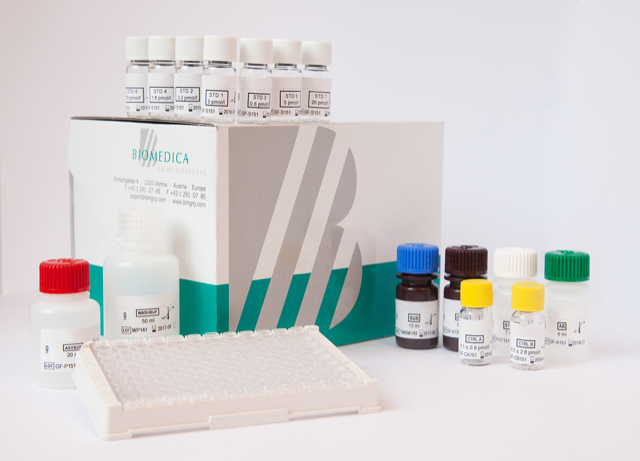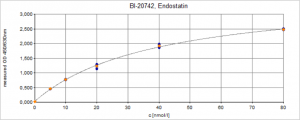Endostatin ELISA Assay Kit
Endostatin ELISA Assay Kit Developed and Manufactured in Austria by Biomedica
Size: 1×96 wells
Sensitivity: 0.2 nmol/L
Dynamic Range: 5 – 80 nmol/L
Incubation Time: 4.5 hours
Sample Type: plasma, serum, urine
Sample Size: 20 µL
Alternative Names: Human Endostatin ELISA
For Research Use Only
Controls Included
Conversion Factor: ng/ml to nmol/l: 1 ng/ml = 0.05 nmol/l (MW: 20 kDa)
Specificity: This assay recognizes endogenous and recombinant human Endostatin. There is no cross reactivity with human recombinant Collagen Type XV (COL15).
Cross Reactivity: Human endostatin only. No cross-reactivity with COL15A1.
Reference Values:
Median urine (n=789): 20 pmol/l
Median serum (n=59): 51 pmol/l
Median citrate plasma (n=30): 47 pmol/l
Each laboratory should establish its own reference range for the samples under investigation. Do not change sample type during the study.
Validated for studies of Humans and Rat/Mice.
Assay Principle
The Endostatin ELISA kit is a sandwich enzyme immunoassay for the quantitative determination of Endostatin in human serum, plasma and urine samples. In a first step, standard/control/sample and detection antibody (biotinylated polyclonal rabbit anti-human Endostatin) are pipetted into the wells of the microtiter strips, which are pre-coated with polyclonal goat anti-human Endostatin antibody. Endostatin present in the standard/control/sample binds to the pre-coated antibody in the well and forms a sandwich with the detection antibody. After a washing step, which removes non-specifically unbound material, the conjugate (streptavidin-HRP) is pipetted into the wells and reacts with the detection antibody. After another washing step, the substrate (TMB, tetramethylbenzidine) is pipetted into the wells. The enzyme-catalyzed color change of the substrate is directly proportional to the amount of Endostatin present in the sample. This color change is detectable with a standard microtiter plate reader. The concentration of Endostatin in the sample is determined directly from the dose response curve.
Related Products
Endostatin Mouse/Rat ELISA Assay Kit
Big Endothelin-1 ELISA Assay
Total Soluble Neuropilin-1 ELISA
Learn more about Endostatin and Endostatin Related Studies here:



